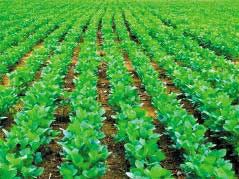|
Researchers Target Soybean Disease With Genetic Resistance Study
URBANA, ILL.
When conditions are just right, sudden death syndrome (SDS) of soybean can cause significant damage and yield loss in crops. University of Illinois researchers studying resistance to SDS will be on hand to share new information on controlling the disease through genetic resistance at this year’s Agronomy Day on August 14.
Cool and wet conditions at planting can put soybean crops at risk for SDS. “This disease has been a problem in Illinois in the past, and the potential is there for it to be a problem this year,” said Lillian Brzostowski, a U of I crop sciences graduate research assistant. “SDS is one of those diseases where it might not occur every year, but when environmental conditions are right, growers can have problems. We had a pretty cool, wet spring, and that’s when the fungus likes to get in the seedling roots.”
Brzostowski will discuss findings from a multiyear trial evaluating genes in soybean that confer some resistance to SDS. Though some genes that confer resistance have already been identified by soybean breeders, Brzostowski said the hope is to find out what genes provide the most resistance when incorporated into multiple genetic backgrounds.
Fusarium virguliforme, the fungus behind SDS, is a soil-borne pathogen that infects soybean early in the season, which, Brzostowski said, makes methods such as tillage, crop rotation, or fungicides ineffective at limiting disease symptoms. “Once this fungus colonizes the roots, there is no spray for it. There is no quick fix. Once your plants are planted in the field, there’s nothing you can do about it.”
Because of this, the most effective way of controlling the disease is through breeding for genetic resistance.
As part of the study, Brzostowski explained that three genes that are known to confer some resistance were incorporated into multiple, high-yielding lines representing different maturity groups. Lines were planted in Urbana, southern Illinois, and Michigan.

“One thing about this disease that is especially troubling is that it tends to pop up in fields that have the highest yield potential and that are irrigated because these plants in these fields are photosynthesizing very well, and that means that the toxin the fungus makes can move through the plant more efficiently,” Brzostowski said.
At planting, the researchers inoculate the soil with the fungus in order to bring about as many foliar symptoms of the diseases as possible. Ratings are then taken on which lines showed the worst or least symptoms of the disease.
Through the trials, the researchers have been successful at confirming a gene that would be a “good candidate” for breeders to use in improving resistance to SDS. The gene (mapped to chromosome 17) was grown and observed in trials both in Urbana and Michigan in 2012 and 2013.
“We have seen success with this gene across genetic backgrounds,” Brzostowski said. “The differences in what we’re seeing aren’t huge, but looking at them statistically, it’s significant.”
If this gene continues to show success across multiple environments, the researchers will start incorporating it into breeding material. “The hope is that maybe we can find multiple genes that could be stacked together,” Brzostowski said. “The thing about SDS resistance is that it’s not just one gene, it’s many genes that have a small effect. We want to identify as many genes as we can to have more options for resistance and then put them together to give the growers the best resistance possible.
“Now even the most resistant commercial variety will show SDS symptoms if the conditions are right. A resistant line is going to do better than a susceptible line, though, because SDS can really do a number on a susceptible line,” she added.
Brzostowski explained that SDS is one of the top five causes of yield loss, disease-wise, in soybean. If a crop is infected with the disease, the researcher said yield losses could be anywhere from 5 percent up to 80 or 90 percent, with typical losses of 15 to 20 percent.
Early symptoms of the disease tend to show up just after the flowering stage as scattered spots appear on the leaves of the plant, giving a mottled look.
The 58th annual Agronomy Day will take place on U of I’s Urbana-Champaign campus. Agronomy Day attracts nearly 1,000 people each year seeking the latest information on technology and techniques to improve food and fuel production. For more information on speakers and displays, “like” University of Illinois Agronomy Day on Facebook, or visit the Agronomy Day website at agronomyday.cropsci.illinois.edu . ∆
|
|